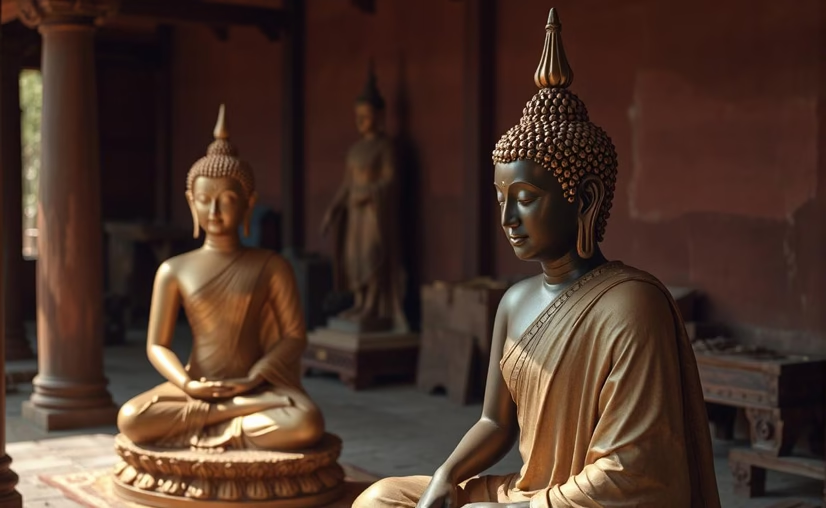Ancient Buddhist Society: A Confluence of Life and Values

Ancient Buddhist Society: A Confluence of Life and Values
Ancient Buddhist communities flourished through their integration of wisdom and compassion which infused spiritual values into daily activities to build ethical societies.
The period from the 5th century BCE to the 12th century CE saw Buddhist society develop into an energetic union of daily existence and moral principles under the direction of the Buddha’s doctrines. The foundation of Buddhist society in wisdom and compassion influenced social institutions as well as ethical norms throughout India and other regions. The harmonious integration of spiritual principles with practical day-to-day living in Buddhist societies fascinates me as a historian studying these traditions because their legacy remains one of balance and profound understanding.
The Structure of Ancient Buddhist Society
The foundation of Buddhist society consisted of the monastic sangha together with lay followers who followed the Four Noble Truths and Eightfold Path. During the 1st century BCE the Pali Canon became the standard for ethical behavior. Buddhism based its social structure on individual merit which enabled people to move up the social ladder unlike rigid caste systems. According to Scholar Richard Gombrich the inclusive nature of Buddhism drew people from various backgrounds and helped establish unified communities.
Social Components
- Sangha: Monks and nuns served as both guardians of teachings and exemplars of mindfulness.
- Lay Community: The lay community maintained the monasteries by providing support through almsgiving while practicing the Five Precepts.
- Royal Patronage: According to his edicts King Ashoka used his resources to build stupas and viharas.
Ethical Values Shaping Daily Life
The ancient Buddhist society emphasized compassion (karuna) and non-violence (ahimsa) as essential principles. The Dhammapada promoted ethical living by teaching principles such as “Avoid evil, do good, purify the mind,” while laypeople adhered to precepts like killing avoidance and monks followed 227 Vinaya rules. Research published in the 2020 Journal of Buddhist Ethics demonstrates the role of Buddhist values in fostering social harmony and resolving conflicts.
Key Practices
- Almsgiving: Lay support for monks strengthened community bonds.
- Meditation: Mindfulness practices enhanced personal and social peace.
- Festivals: The Vesak festival brought people together to honor Buddha’s life and teachings.
Our article on Essence of Buddhist Sutras uncovers additional relevant teachings.
Cultural Contributions
Buddhist society made cultural contributions through its advancements in art forms as well as educational and literary achievements. The UNESCO World Heritage Site of Sanchi Stupa contains carvings that illustrate Jataka Tales stories. The 2019 Journal of Buddhist Studies report states that Nalanda University trained large numbers of students who carried Buddhist teachings across Asia. The Buddhacarita represents a literary fusion of spiritual themes and artistic style.
Cultural Elements
- Art: Gandharan sculptures merged Indian and Greek aesthetics.
- Literature: Jataka Tales taught compassion through storytelling.
- Education: Taxila and Nalanda fostered interdisciplinary learning.
Further information about Nalanda and Taxila can be discovered in our post.
Influence on Governance and Society
Emperor Ashoka of the 3rd century BCE led governance with Buddhist values that produced edicts supporting tolerance and welfare. The British Museum holds records of more than 30 edicts that promote dharma. Buddhist communities demonstrated compassion through public policy by establishing hospitals and rest houses as charitable institutions.
Societal Impacts
- Ethical Leadership: Rulers adopted non-violence and justice.
- Social Welfare: Free healthcare and education reduced inequality.
- Interfaith Harmony: Buddhism coexisted with Jainism and Hinduism.
For more information about Ashoka’s impact, read our article.
Why This Society Matters Today
The ancient Buddhist society’s focus on wisdom and compassion serves as a guide to present-day ethical standards and community development. A 2021 Mindfulness journal study confirms that mindfulness practices produce mental health advantages. According to a 2022 Heritage Studies report international visitors to places such as Bodh Gaya develop worldwide appreciation through cultural tourism.
Ways to Engage
- Study Texts: Read the Dhammapada at Access to Insight.
- Practice Mindfulness: Meditate using Metta Sutta techniques.
- Visit Sites: Explore Sanchi or Anuradhapura for historical insight.
- Support Heritage: Advocate for UNESCO preservation efforts.
FAQ: Ancient Buddhist Society
- Q: What defined ancient Buddhist society?
- A: The community combined wisdom and compassion to unite monastic and lay lifestyles through ethical principles taught by the Buddha.
- Q: How did Buddhist values influence daily life?
- A: The foundational Buddhist practices of almsgiving and meditation along with celebrating festivals followed principles of compassion and non-violence which supported harmonious living and moral conduct.
- Q: What cultural contributions did Buddhist society make?
- A: Buddhist society created stupas as well as literary works such as the Jataka Tales while founding educational institutions like Nalanda which improved art forms and storytelling alongside educational systems.
- Q: What impact did Buddhist principles have on the governmental systems of ancient civilizations?
- A: The leader Ashoka implemented Buddhist principles which supported welfare programs and policies that encouraged tolerance and non-violent practices.
- Q: Where can I find resources to learn about ancient Buddhist society?
- A: Find resources at Ancient Buddhist Texts or Buddhist Digital Resource Center.
Conclusion: A Legacy of Harmony
In ancient Buddhist society values and living principles merged together to form a fabric of wisdom and compassion that led to lasting ethical and cultural traditions. Its lessons guide us toward peace today. Comment on Buddhist society here or subscribe for deeper spiritual insights!